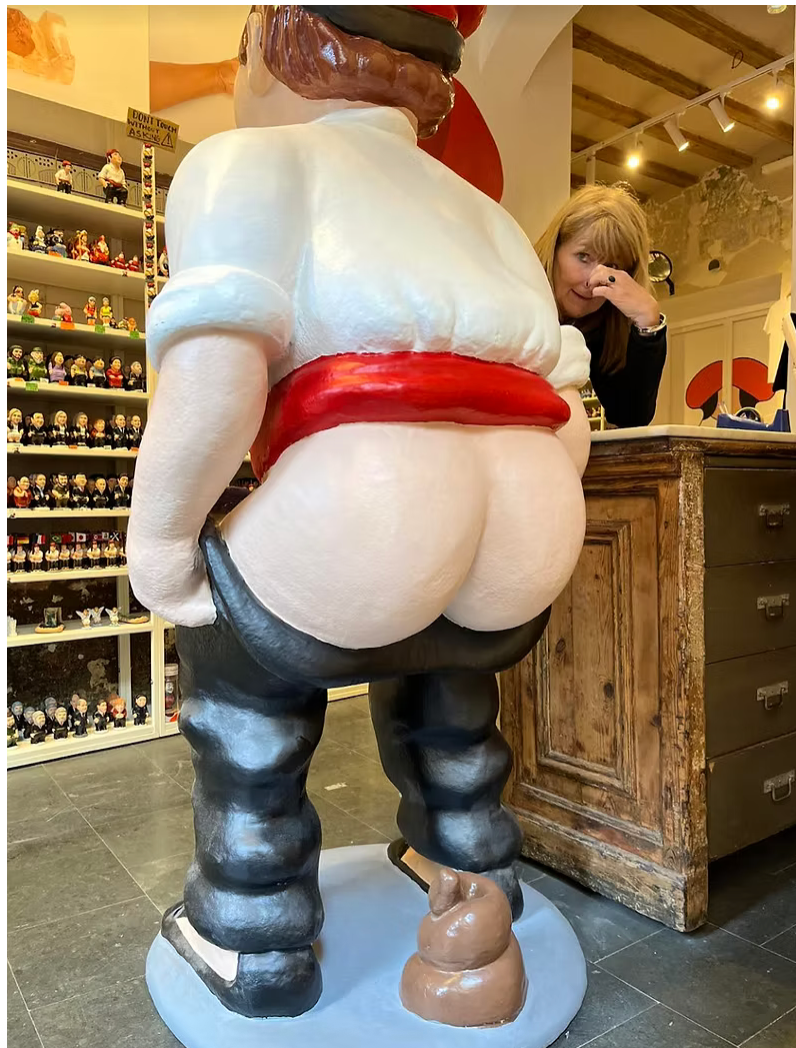Holy Crap, Barcelona! The Catalan Christmas Surprise That Stopped Us Cold
- Naughty Gnome

- Mar 27, 2023
- 3 min read
Updated: Nov 22
Sourcing trips are supposed to be predictable. You walk, you browse, you compare, and you politely debate whether anyone back home truly needs one more variation of a candle holder. Barcelona was meant to be the calm bookend to a long week of decisions. One day to decompress, admire architecture, and remember what it feels like to look at objects without calculating wholesale margins.
Then we reached the Gothic Quarter and spotted something impossible to ignore.
A small figurine tucked near a shop entrance, posed in a perfect squat over an unmistakable little pile. So casual. So confident. So committed. You could smell it in your imagination long before your brain accepted what you were seeing.
It was, quite literally, a holy crap moment.
The Giant in the Shop

We stepped inside the shop expecting maybe a shelf or two of novelty items. Instead, we walked straight into the backside of a life sized caganer. Full squat. Full commitment. No hesitation. It was so unexpected and so boldly rendered that our brains needed a full second to catch up. If the tiny figure outside made us pause, this one stopped us completely. You do not prepare for something like that. You just stand there, laugh, and accept that you have entered a very different chapter of the trip.
Once we finally looked away, we noticed the rest of the room. Floor to ceiling shelves packed with smaller figures in the exact same pose. A whole regiment of squatters, each one perfectly still and perfectly earnest. That was the moment we realized we had not stumbled into a novelty shop at all. We had walked into the center of a long running Catalan Christmas tradition.

A Crowd of Tiny Squatters
Shelves were lined with the iconic originals. Dozens of little squatters in red caps, all frozen in identical poses. It felt like a festive search party that got distracted by more urgent personal business. Absurd, yes, but also strangely delightful.
What Exactly Is a Caganer?
The shopkeeper explained it with the calm of someone who does this all day. The caganer is a traditional Catalan Christmas figure dating back to the eighteenth century. He is tucked discreetly into the nativity scene, hidden from plain view. Children search for him the way others search for elves. It becomes a game. A tradition within a tradition.
One origin story tells of a farmer who had no grand gift to offer the Christ child, so he contributed what he could. Fertilizer. A humble gesture meant to nourish the land and the coming year. Over time that meaning softened, then evolved.
If you want a deeper look at its history, you can explore the tradition at the Toy Museum of Catalonia, which explains how the caganer became a symbol of good fortune and “fertilizing the earth.”
Today, the caganer appears in many forms. Athletes. Actors. Politicians. Musicians. Even royalty. All portrayed with the same humorous vulnerability. A reminder that status dissolves in the face of common humanity.

Hidden in Every Nativity Set
Seeing him tucked on the rooftop of a nativity display brought the whole tradition into focus. The caganer is hidden, never centered. Children race to find him. Adults pretend not to see him. The ritual is lighthearted, but the message is gentle and honest.
Even the most polished scenes make space for imperfection.
Celebrity Squatters

Modern shelves expanded the cast. World leaders. Movie stars. Musicians. Sports icons. Dozens of instantly recognizable faces, all squatting with the same unwavering dedication. If you ever needed proof that humor is the great equalizer, Barcelona has carved it in clay.
Barcelona Beyond the Bathroom Humor
Stepping back onto the street, the rest of Barcelona felt different. The city has always held opposites in harmony. Gothic archways next to modern curves. Classic markets beside contemporary galleries. Serious art balanced with play.
The caganer fits right in. A centuries old tradition that embraces humor without losing heart. It is irreverent, but not dismissive. Funny, but grounded. Honest in a way that is strangely moving.
Barcelona celebrates beauty and absurdity with the same ease. That balance might be its greatest charm.
A Final Note From Home
Back at Naughty Gnome headquarters, our own Sven Stinky Gnome sits proudly on the shelf with a renewed sense of purpose. Meeting the caganers of Catalonia changed him. He left the studio as a mischievous troublemaker, but he returned knowing he belongs to a much older, much stranger lineage. He now carries himself with the quiet confidence of someone who has seen his people out in the world and realized he is not an oddity at all.
Sven understands now that humor has history and that even the silliest figures can hold their own place in a tradition. He is part of a much bigger story. And he is among very good company.





Comments